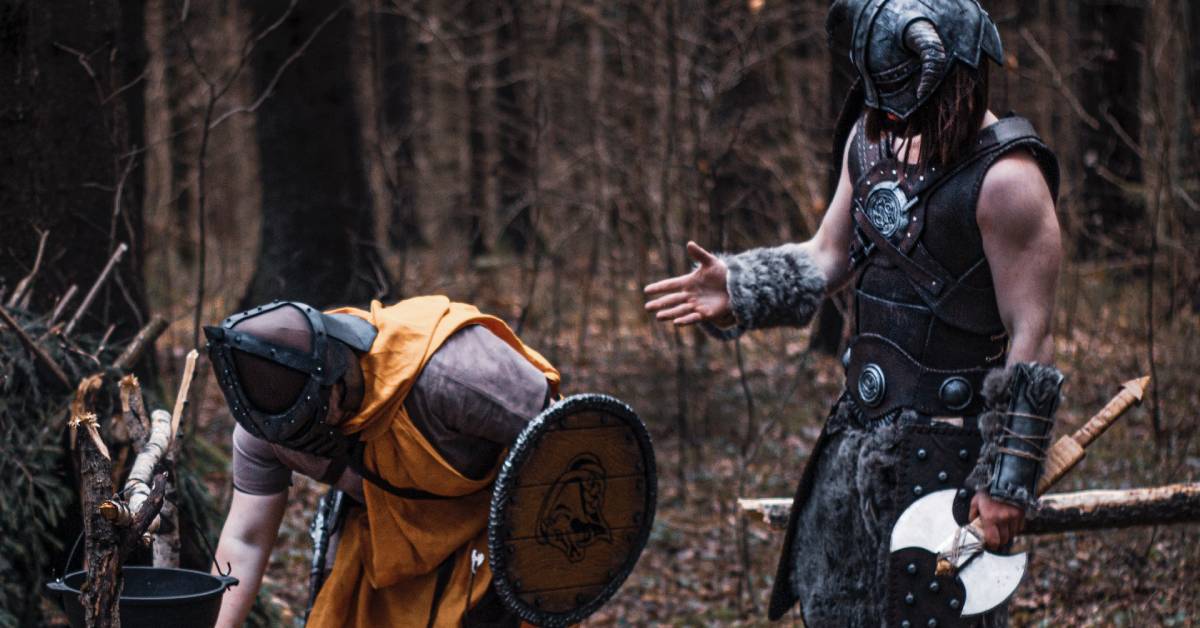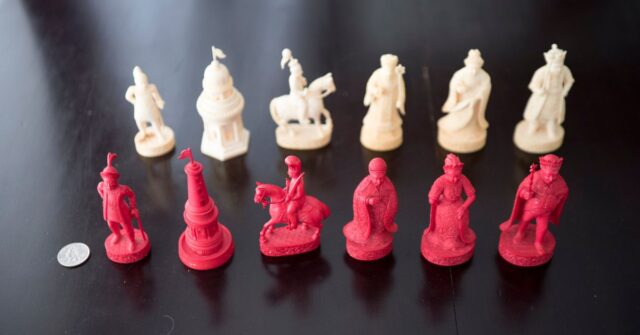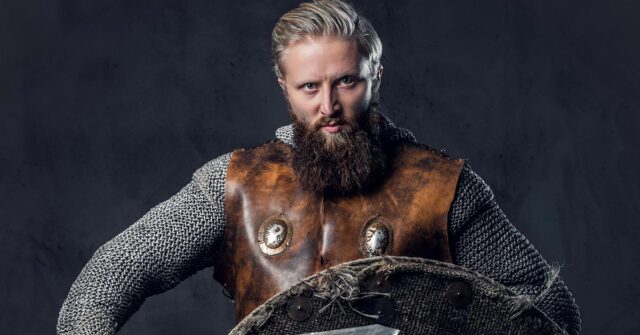The Viking era, extending from the late 8th to early 11th century, holds a captivating allure. A crucial part of understanding Viking culture is the exploration of their attire or ‘garb.’
This article is a comprehensive guide to authentic Viking clothing, taking into account historical evidence and scholarly interpretations.
Introduction to Viking Culture and Clothing
Getting acquainted with Viking culture is best started by investigating their clothing, an integral part of their daily life and societal identity.
Viking clothing was more than just a means of protection from the elements; it was a display of personal status, wealth, and even beliefs.
The Importance of Clothing in Viking Society
Throughout the Viking Age, clothing served as an immediate indicator of a person’s societal standing. Distinctive styles and accessories were often used to denote rank, profession, and origin.
Clothing was intricately linked with societal norms and customs, and each garment held a certain significance.
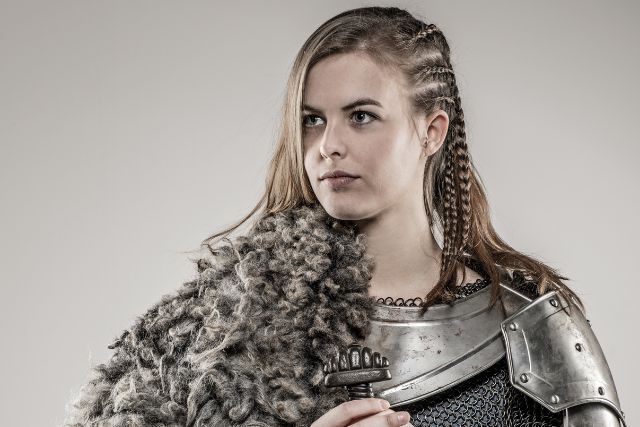

Materials Used in Viking Garb
Viking clothing was made from a range of materials that were readily available in their environment. Most commonly, wool and linen were used, while the wealthy sometimes wore garments of silk.
Animal skins and furs were also utilized, particularly in colder climates or during the winter months.
Understanding Viking Garb: From Head to Toe
To truly understand Viking attire, we must explore the various components that made up a complete outfit. This includes headwear, upper and lower body attire, and footwear.
This will give us a holistic view of how a Viking individual might have dressed during the period.
Headwear in the Viking Age
Contrary to popular belief, Viking headwear typically did not include horned helmets. Instead, they wore simple caps or hoods made from wool or other available materials.
Hats and Hoods
Hats and hoods provided necessary protection from the harsh Scandinavian climate. They were often made from wool or animal skins and were simple in design.
Some caps were made from rectangular pieces of cloth, sewn together at the sides, while others were more complex in their construction.
Helmet Myths and Facts
The iconic image of a Viking wearing a horned helmet is more myth than fact. Archaeological evidence suggests that most Vikings did not wear helmets at all. When helmets were used, they were typically simple, conical, or rounded metal caps, designed to protect the head in battle.


Viking Upper Body Attire
Viking men and women wore different styles of upper-body clothing, though there were some commonalities. Both genders usually wore a form of a tunic, and the clothing was practical and suited to their lifestyles.
Men’s Tunics
Viking men typically wore a simple tunic, often made from wool. The tunic was usually knee-length and was worn over trousers. Tunics were typically fitted at the waist and featured an opening at the neck, which could be fastened with a brooch or pin.
Women’s Overdresses
Viking women wore a kind of overdress known as a hangerok. This garment, akin to a pinafore, was worn over a longer underdress and was held up by a pair of brooches at the shoulders. The overdress often extended to ankle length and was usually worn with a belt.
Protective Armour: Chainmail and Shields
Vikings involved in warfare often wore protective armour. Chainmail was common, made from interlinked iron rings. In addition, Vikings carried shields for protection, usually round and made from wooden planks, with a central boss made of iron.
Viking Lower Body Attire
For the lower body, both men and women wore items suited to their gender and the practical needs of their society. This involved trousers for men and underdresses for women.
Trousers and Leggings
Men wore trousers made from wool, often fitted tightly around the legs. Some trousers were loose-fitting and baggy, designed for comfort and freedom of movement. For extra warmth, they could also wear leg wraps or puttees – strips of cloth or leather wound around the lower leg.
Women’s Underdresses
Underneath the overdress, Viking women wore a full-length underdress, often made from linen. It was typically long-sleeved and could be worn alone in the house or under the overdress when going out.
Viking Footwear
Vikings wore robust footwear, suitable for the harsh Nordic climate and their active lifestyle. Shoes and boots were typically made from leather, stitched together with leather thongs or sinew.
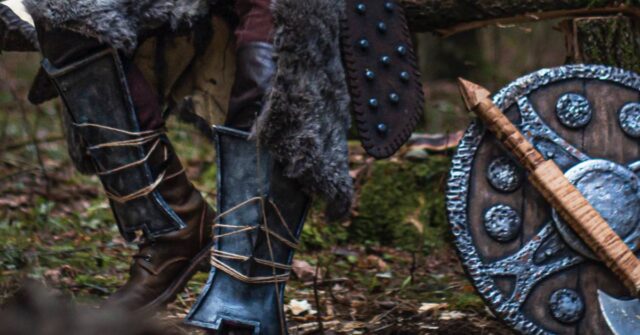

Leather Shoes and Boots
Viking shoes and boots were usually made from a single piece of leather, stitched up the center to create a simple, effective design. They were often mid-calf in height and could be lined with fur for additional warmth in the colder months.
The Role of Jewelry in Viking Dress
Jewelry played a significant role in Viking dress, often symbolizing status, wealth, and religious beliefs. It was not just decorative, but also functional, often used to fasten clothing or denote societal standing.
Amulets and Symbols: The Spiritual Significance
Many Vikings wore amulets or symbols as part of their personal adornment. These could represent various gods or spiritual beliefs and were often thought to offer protection or good fortune to the wearer.
They were typically made from metal, bone, or wood, and were worn as pendants or hung from clothing.
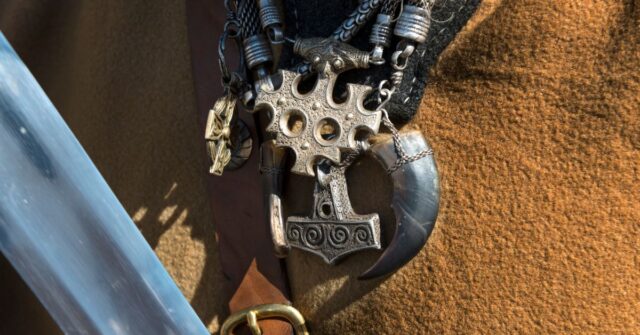

Brooches and Pins: More Than Just Decorative
Brooches and pins were commonly used in Viking fasion to fasten clothing or to display status.
They were often ornate, with intricate designs, and could be made from a variety of materials including bronze, silver, or gold for those of high status.
Arm and Neck Rings: Displaying Wealth and Status
Arm rings and neck rings, often made of silver or gold, were also popular in Viking culture. These items were not only decorative but were also a way of storing and displaying wealth.
They could be easily removed and used as currency, demonstrating the wearer’s affluence.
Weather and Seasonal Influence on Viking Dress
The Viking lands, characterized by harsh winters and relatively mild summers, necessitated adaptable clothing.
The material and style of Viking garb varied with the seasons, employing heavier wools and furs in the colder months and lighter linens in the warmer seasons.
Winter Garb: Furs and Heavy Woollens
During the chilly winter months, Vikings relied on heavy woollen clothing and furs for warmth. Cloaks made from wool or animal skins were worn over tunics, and hoods or hats were used to protect the head.
Footwear was often lined with fur for added insulation.
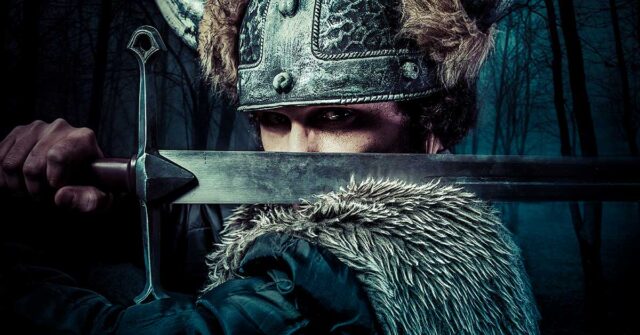

Summer Garb: Linens and Lighter Fabrics
For the summer, lighter fabrics like linen were preferred. Tunics and dresses were often made from this breathable material, providing comfort during the warmer months.
Viking footwear also adapted to the weather, with lighter leather shoes becoming common.
Viking Dress Across the Viking World
The Viking world spanned several countries, leading to variations in clothing styles influenced by different climates, cultures, and resources. Moreover, the far-reaching Viking expeditions also had an impact on their dress.
Variations in Viking Garb: Scandinavian Countries
Despite sharing a common cultural background, there were regional differences in Viking dress across Scandinavian countries.
For example, Norwegian Vikings were more likely to use reindeer hide in their clothing due to the abundance of reindeer in Norway. Danish Vikings, on the other hand, used more wool in their clothing as sheep farming was prevalent in Denmark.
Impact of Viking Expeditions on Clothing Styles
The far-reaching expeditions of the Vikings exposed them to different cultures and their clothing styles.
For example, contact with the British Isles, Europe, and Asia led to the introduction of new fabric types like silk, which was then incorporated into the dress of wealthier Vikings.
Similarly, new jewellery styles and decorative motifs were adopted and adapted into their own dress.
Viking Children’s Clothing
Just like adults, Viking children were dressed in practical, durable clothing suited to the Nordic climate and their active lifestyles. Their attire was a smaller version of adult clothing, preparing them for their roles in Viking society.
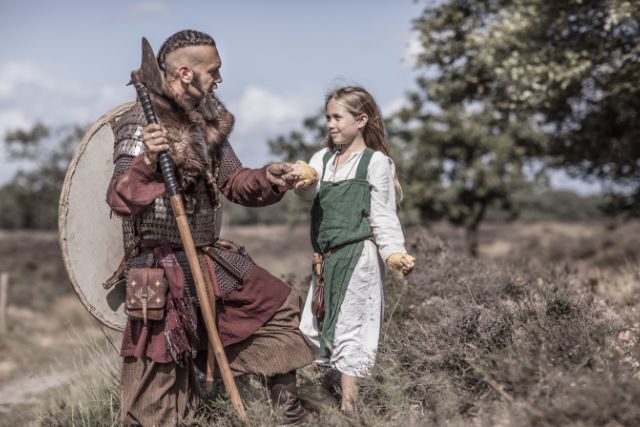

From Infancy to Adolescence: How Viking Children Dressed
From a young age, Viking children wore tunics and dresses similar to those of adults. As they grew older, their clothing became more differentiated by gender, with boys moving on to wearing trousers and girls wearing the overdress.
Just like adults, their clothing also varied with the seasons and was suitable for the harsh Nordic climate.
The Role of Color and Dyes in Viking Garb
The use of colour was an important aspect of Viking clothing and was often indicative of social status. The use of natural dyes gave their clothing a range of colours, from vibrant reds to muted browns and greys.
Colours of Status and Profession
The colour of Viking clothing could indicate the wearer’s profession or status. Bright colours like red, blue, or yellow were often associated with high status as they required expensive dyes.
Darker colours were more common among the working classes. Certain colours could also be associated with specific professions, like the blue worn by merchants.
Natural Dyes and Their Sources
Vikings used natural sources to dye their clothing. This included plants, bark, and lichens. For example, the woad plant was used to produce a blue dye, while bedstraw yielded a red dye. Black and brown dyes could be obtained from the bark of the oak tree.
Textile Crafts in the Viking Age
Vikings were skilled in various textile crafts, including weaving and embroidery. These skills were vital in the production of their clothing and also allowed for the intricate decoration of their garments.
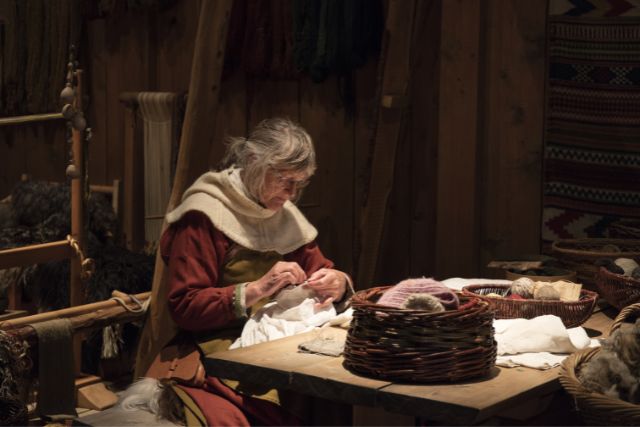

Weaving and Knitting: Home Textile Production
Weaving was a key skill in the Viking household, with women primarily responsible for producing the fabric for their family’s clothing. This was done on a vertical loom, producing a woollen cloth.
Knitting was less common, but evidence suggests it was used to create items like socks and mittens.
Embroidery and Decoration in Viking Age Textiles
Embroidery was used to add decorative elements to Viking clothing, often using brightly coloured thread to create geometric patterns or animal motifs.
The patterns could hold symbolic meaning and were a way of personalizing and enhancing the wearer’s clothing.
Recreating Authentic Viking Garb Today
Interest in Viking culture and fashion remains strong today. While modern materials and techniques can be used to recreate Viking attire, adhering to traditional methods and designs can result in a more authentic representation of Viking garb.
Modern Materials vs. Traditional Techniques
Modern materials like synthetic fabrics and dyes can mimic the look of Viking attire, but they lack the authenticity of wool, linen, and natural dyes.
On the other hand, using traditional techniques like weaving on a vertical loom or sewing by hand can lend authenticity to recreated garments.
Getting Started: Patterns and Tutorials
Recreating Viking clothing can be a rewarding experience. Patterns and tutorials can be found online, many of them based on historical evidence from archaeological finds.
These resources can guide you in making your own Viking garb, whether you’re aiming for a historically accurate representation or a more modern interpretation.


Conclusion
Understanding Viking garb offers insightful glimpses into the daily life, societal structure, and cultural beliefs of the Vikings.
From practical tunics and trousers to intricately decorated jewellery, Viking clothing was a testament to their adaptability, craftsmanship, and keen sense of personal identity.
Today, the legacy of Viking attire continues to captivate and inspire, bridging the centuries between the past and the present.

